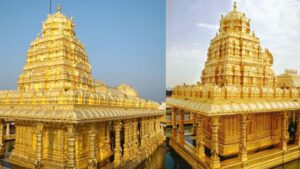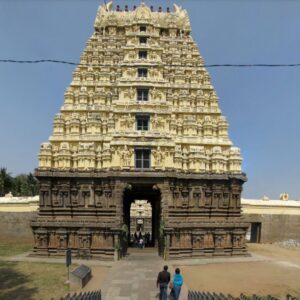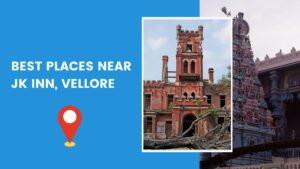In 1921, the Vellore Fort (including the temple) came under the care of the Archaeological Survey of India. Worship had not resumed for many years. In 1981, devotees secretly brought back the deity and reinstated worship. The first kumbabishekam (consecration) was held in 1982, and subsequent ones in 1997 and 2011. It is a hindu worship place of Lord Shiva where devotees come for prayers, perform rituals, and seek blessings.
This temple has the spiritual presence of Lord Shiva, said to bless visitors with purity and spiritual awakening to those who visit with sincere devotion and respect. And It is a beautiful combination of spiritual devotion with architectural richness.
The temple remained inactive for nearly 400 years before worship resumed in the early 1980s, and today it draws many devotees and tourists.

Table of Contents
Historical Significance and Origins
The temple was built around 1550 CE under the Vijayanagara rulers, linking it clearly to that era. The name “Jalakandeswarar”, derived from the Sanskrit words “Jala” meaning water and “Khandeshwar” a title of Lord Shiva, translates to Lord Shiva dwelling in water. It is believed that the temple was named for its nearness to water.
This temple is closely connected to the Vellore fort that highlights its cultural importance during the period and the construction of the temple and its connection to the fort, highlights its significance in the historical and cultural heritage of the region. For centuries, It remained an important centre for worship of Lord Shiva.
A recent study “Impact of Tourism in Economic Development – Vellore District” (2024) acknowledges Jalakandeswarar Temple as one of several religious and cultural sites contributing to tourism in Vellore.
Divine Myths of the Temple
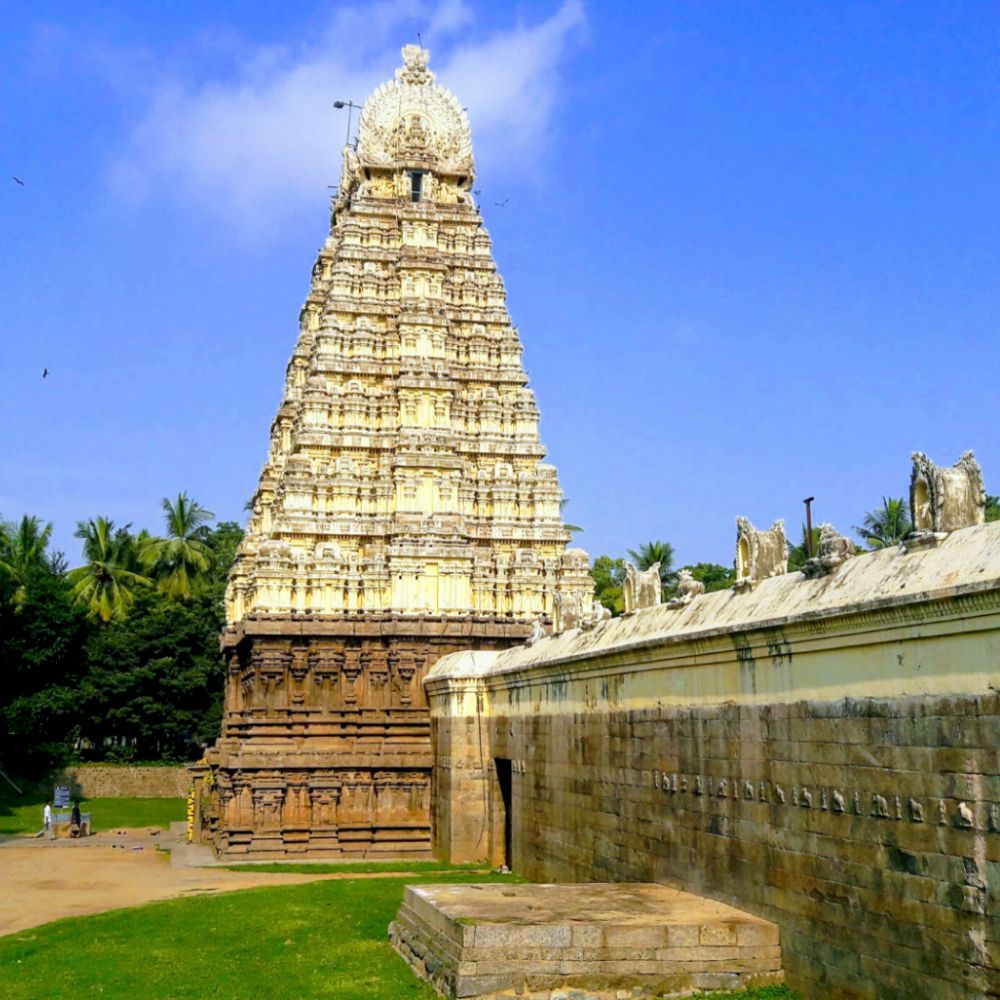
Lord Jalakandeswarar is a form of Lord Shiva, the eternal god of the temple, honoured by devotees for his presence. This temple plays an important role in Hindu rituals and a major place for Lord Shiva worship in the region.
The speciality of this temple is, all the three lords are with their consorts- Lord Shiva with mother Parvathy, Lord Vishnu with mother Mahalakshmi and Lord Brahma with mother Saraswathy.
There are several myths and legends associated with Jalakandewarar temple. One popular myth is that the temple was built on a spot where holy water once existed and Shiva manifested to bless the land.
Architectural Highlights
The Jalakandeswarar temple is a magnificent example of Dravidian Architecture where the style is highlighted by stone carvings, tall gopurams rising over 100 feet, carved with fine detail and huge pillars, wooden gates, Vimana, and stunning sculptures.
This temple has a mandapam that has a two-faced sculpture of a bull and an elephant and a hall supported by symbolic creatures of horses, yalis(lion like creatures and carvings of god and goddess and is as beautiful as 1000 pillared mandapam in Madurai Meenakshi Amman temple.
Holy water and its Significance
The temple sits within a water tank (called Agazhi in Tamil) and is surrounded by water. The tank is traditionally claimed to have a circumference of 8,000 ft, though some sources simply describe it as a moat-like water boundary.
This water is used for the bathing of deity(Abhishekam), drawn from the earliest well called Ganga Gouri theertham, considered powerful for purification purposes.
In Hinduism, water has a huge importance, as a symbol of purity, spiritual cleansing, and rituals at temples. The Vedas identify water as the essence of spiritual sacrifice, a process of attaining spirituality.
Religious Significance and Festivals
Are there any festivals celebrated in Jalakandeswarar temple? Yes, The temple has a main role in Hindu religious life especially for devotees of Lord Shiva and deeply influences local traditions and spiritual life of the community.
Temple celebrates various festivals throughout the year like Maha Shivaratri, Karthigai Deepam, Panguni Uthiram, and Arudra Darshan that deepen the spiritual connection between devotees and deity. Other festivals celebrated here are
10 days Chithra Poornima (April-May)
10 days Aadi Pooram (July-August)
Vinayaka Chaturthi in Avani(August – September)
Navaratri ( september-October).
Temple Restoration and Preservation
The Tamil Nadu government and Archaeological Survey of India’s (ASI) efforts for restoration helped to preserve the temple’s carvings and sculptures, aimed to maintain structural stability and artistic beauty.
Recently, restoration efforts have been all about fixing up the damaged parts of the temple, strengthening its base, and giving a good clean to the old carvings and wall painting to bring them back to their old glory.
The Jalakandeswarar temple is designated as a protected monument for its cultural, historical and architectural significance, making sure it receives care wanted for its preservation.
Best Time to Visit Jalakandeswarar Temple
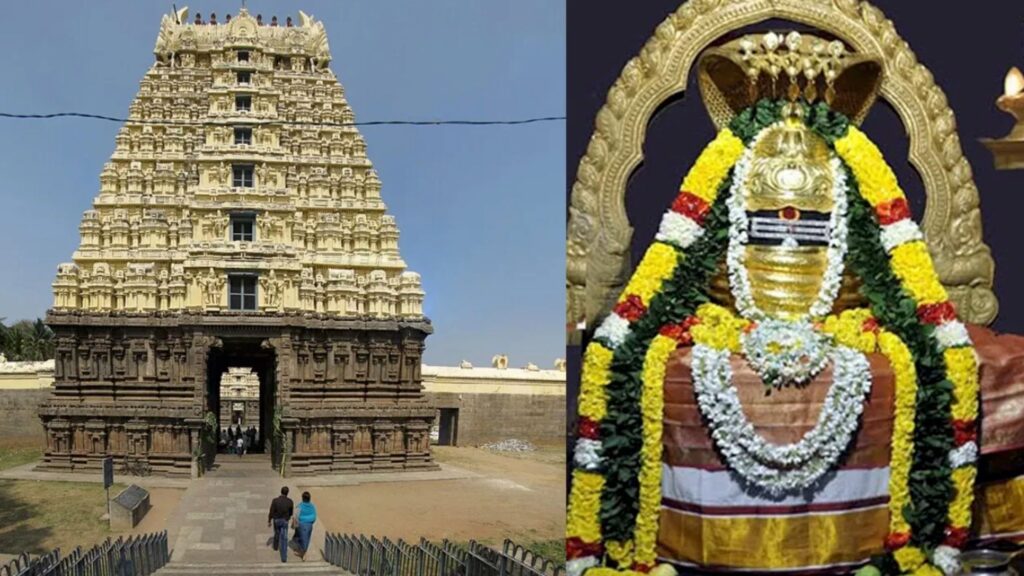
Don’t know when to visit Jalakandeswarar temple?
The temple is open daily from 6:30 AM – 1:00 PM and 5:00 PM – 8:30 PM. Note that on festival days or special occasions, timings may adjust.
The best time to visit Jalakandeswarar temple is during the festivals like Maha shivaratri or Karthigai deepam, Dussersa. On those occasions the temple will be filled with colours, lights and get a true feel of traditional culture and vibrant spiritual experience.
There is no entry fee, making it anyone can visit the temple and the visitors will get basic facilities like drinking water, areas for resting, and also provided spaces for prayers. The temple is easily reached from Vellore and other nearby attractions, making it easy for tourists who come to explore the region.
Government Museum, Science Park, Vainu Bappu Observatory, Srilakshmi Golden Temple, Big Mosque & St. John’s Church and Yelagiri Hill station are the other tourist attractions around Vellore. You will get exclusive offers, if you visit the temple during monsoon and winter seasons, when surroundings appear green and heavenly with rainfall.
Visitor Tips & Etiquette
To make your trip comfortable and respectful:
- Dress Code: Wear modest clothing. Cover shoulders and knees.
- Shoes: Remove footwear before entering the inner sanctum.
- Photography: Allowed in most areas, but avoid disturbing rituals.
- Festival Days: Carry water, light snacks, and be ready for queues.
- Accessibility: The temple is friendly for families and elderly visitors, though some steps may need assistance.
How to Reach Jalakandeswarar Temple
- By Air: Nearest airport – Chennai (approx. 130 km). From there, taxis and buses are available.
- By Train: Vellore Town and Katpadi Junction are the closest railway stations.
- By Road: Well-connected via NH 48; buses and private cabs are frequent.
Nearby attractions to combine with your trip: Government Museum Vellore, Christian Medical College Chapel, and Amirthi Zoological Park.
Experiences Not to Miss
- Watch the temple’s reflection in the Agazhi water tank at sunrise.
- Attend evening aarti for a spiritual atmosphere.
- Explore the surrounding Vellore Fort, which has other temples, mosques, and churches inside.
- During Karthigai Deepam, witness the magical glow of thousands of lamps.
Conclusion
In conclusion, Jalakandeswarar temple in Vellore is a great example of Vijayanagar architecture. It is a place of worship and a symbol of TamilNadu’s unique spiritual experience. Whether you are a devotee or a tourist who comes to explore the beauty and peace, Jalakandeswarar temple welcomes you with glad hands. Its annual festivals, stunning sculptures, and peaceful surroundings give you an unforgettable journey.
Looking for a comfortable hotel to stay near in Jalakandeswarar temple?
JK Inn is the best hotel in Vellore you can consider choosing. It is just 1.5 from the temple, where you get comfortable rooms and best dining options.
You will get exclusive offers in hotels, if you visit the temple during monsoon and winter seasons, when surroundings appear green and heavenly with rainfall. With transportation services and tourist attractions, Vellore is a perfect destination for explorers.
Frequently Asked Questions
What are the temple timings?
The temple is generally open from 6:00 AM – 12:00 PM and 4:00 PM – 8:00 PM (timings may vary on festivals).
Is there an entry fee?
No, entry is free for all visitors.
Can non-Hindus visit?
Yes, visitors of all faiths can enter the temple, but respect local customs.
What is the dress code?
Modest attire covering shoulders and knees is recommended.
Is the temple part of Vellore Fort?
Yes, the temple is located inside the historic Vellore Fort.


